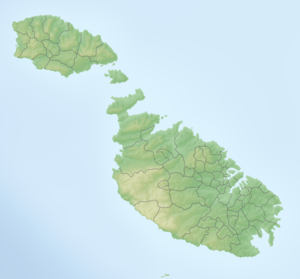Ramla Bay (Gozo)
| Ramla Bay | ||
|---|---|---|
|
Ramla Bay |
||
| Waters | Mediterranean Sea | |
| Land mass | Gozo | |
| Geographical location | 36 ° 3 '43 " N , 14 ° 16' 59" E | |
|
|
||
| width | approx. 400 m | |
Ramla Bay is a bay with a sandy beach in the north of the island of Gozo in the Maltese archipelago.
location and size
The bay has a width of approx. 400 meters and is bordered by two table mountains . In the center of the bay there is a short river that carries precipitation into the bay when it rains heavily, but is otherwise mostly dried out. Ramla Bay is located between Marsalforn Bay in the west and San Blas Bay in the east and can be reached by road from the towns of Nadur and Xagħra .
geology

The typical geological stratification of the island of Gozo can be clearly seen in the delta-shaped bay. In the upper area of the mountains, above a height of about 105 meters around the bay, there is a relatively young limestone location, the Upper Coralline Limestone Formation . This location has a thickness of about 35 meters and an age of about 7 million years. Below that, in relatively thin layers, around 50 cm wide, is the Greensand Formation . This layer consists of sandstone , which is striking because of its green color, which is caused by the high concentrations of the mineral glauconite . The age of this layer is around 6 to 10 million years. The blue clay formation dominates the slope areas , a layer of clay minerals that is noticeable due to its grayish discoloration. It has a thickness of about 50 meters and an age between 10 and 15 million years. In the lower part of the bay is the beige Globigerina Limestone Formation , from which the building material typical of Malta is made. This layer is about 18 meters thick and is 15 to 20 million years old. The bay's beach consists largely of this location. An approximately 400-long strip of sand dunes joins the beach, several meters high in some places. The outer areas are covered with vegetation.
Importance for tourism
Ramla Bay is considered to be the most beautiful and most important bathing beach on the island of Gozo. This is of great importance for local tourism. Above the bay is the Calypso Cave (calypso grotto), of which it is said that Odysseus lived there for seven years with the nymph Calypso .
environment
Ramla Bay used to be an important breeding ground for aquatic turtles . For many years, however, no turtles have come to lay their eggs in the bay. The Malta Environment and Planing Authority (MEPA) is now considering designating the area from Ghan Barranji to San Blas Bay as a protected area. As part of the “Poseidon” project, Ramla Bay is also to be declared a marine protected area.
vegetation
On the steep slopes above the bay you can find Mediterranean-typical plants such as the tamarisk ( Tamarix africana and Tamarix gallica ), figs ( Ficus carica ), prickly pear cacti ( opuntia ) and capers ( Capparis spinosa ). The vegetation of Ramla Bay and the nearby San Blas Bay is very similar.
history
For several centuries Gozo was the victim of attacks by Turkish and North African corsairs . The corsair ships also landed their troops in Ramla Bay. For this reason, walls were built underwater to prevent these landings.
Web links
- Għajn Barrani (l / o Xagħra). The Times of Malta , August 18, 2011(English).
- Għajn Barrani area. The Times of Malta, May 19, 2011(English).
- Gozo Views: Ramla Bay
Individual evidence
- ↑ a b Scerri, 2003: GEO-ENVIRONMENTAL SURVEY OF RAMLA BAY - GOZO (pdf; 2.3 MB) ( Memento from March 4, 2016 in the Internet Archive )
- ↑ The Telegraph Best beaches: Ramla Bay, Gozo.
- ^ Poseidon - Marine conservation. ( Memento from June 20, 2012 in the Internet Archive ) Gaia Foundation (English)
- ^ Hans Christian Weber, Bernd Kendzior: Flora of the Maltese Islands. Margrave Publisher, 2006
- ^ Ernle Bradford: The Shield of Europe - the fight of the Knights of Malta against the Turks 1565. Universitas-Verlag, Berlin 1976.



